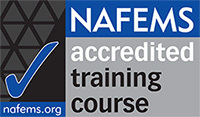Why does a PSD plot have such strange units?
Why are dynamic effects important in shock spectra?
Why does non-linear stiffness dissipate energy?
Get the answers to these questions and more with this industry-leading, code-independent e-learning course on:
Advanced Dynamic FEA
This course covers a broad range of solution types, beyond the usual natural frequency and dynamic response methods. This allows more physical phenomena to be investigated and simulated using dynamics in FEA.
Topics covered include; Random Vibration, Shock and Response Spectra, Nonlinear Dynamic Response, Explicit Dynamic Analysis and Complex Eigenvalue Analysis.
What will you learn?
- The theory behind advanced dynamic analysis techniques
- A practical understanding of advanced applications
- Hints and tips for setting up advanced dynamic analyses
- A roadmap for understanding the results from dynamic analysis
- The limitations of simulation methods
Who should attend?
- Designers and engineers who are familiar with dynamic analysis and want to learn more
- Experienced engineers who want to brush up on their advanced dynamic analysis knowledge
The course is completely code independent.
This is a 4-session online training course, with each session lasting for approximately 2/2.5 hours, depending on homework submissions, questions & discussions.
You can attend the sessions live, and/or stream on demand. When you register you will get access to a dedicated course forum where you can contact the tutor with questions, submit homework, download pdfs of course notes and access all session recordings. To get the most out of the course, participation in forum discussions is encouraged.
Questions? Contact us on e-learning@nafems.org
Course Process and Details
Students will join the audio portion of the meetings by utilizing the VoIP (i.e. headset connected to the computer via headphone and microphone jacks) or by calling into a standard toll line. If you are interested in additional pricing to call-in using a toll-free line, please send an email to: e-learning @ nafems.org .
Course Program
This is a 4-session online training course, with each session lasting for approximately 2.5/3 hours, depending on homework submissions, questions & discussions.
You can attend the sessions live, and/or by listening to the recordings, which will be made available shortly after the end of each session.
Session 1: Shock and Response Spectra
- Importance of Dynamic Effects in Shock
- Shock Spectra Analysis
- Response Spectra Overview
- DDAM overview Response Spectra Analysis – creation of a spectra
- Response Spectra Analysis – application of a spectra
- Response Spectra Examples
- Homework Session 1
Session 2: Random Response
- Homework Review
- Probability and Random theory review
- PSD definition
- Random FE Analysis Overview
- Application of Random Analysis results for Fatigue
- Checking with Miles Equation Random Response Examples
- Homework session 2
Session 3: Nonlinear Dynamics
- Homework Review
- Dynamic Nonlinearity
- Nonlinear Strategy
- Example of Geometric Nonlinearity
- Theoretical Solution
- Numerical solution
- Background to Material Nonlinearity
- Example of Material Nonlinearity
- Theoretical Solutions
- Numerical solutions
Session 4: Explicit and Complex Analysis
- Overview of Implicit versus Explicit Solutions
- Applicability of Explicit techniques
- Explicit Basic Concepts
- Time step calculations
- Simple Example
- Lagrangian and Eulerian solutions
- Complex Eigenvalue Analysis
- Applications using complex Eigenvalues






